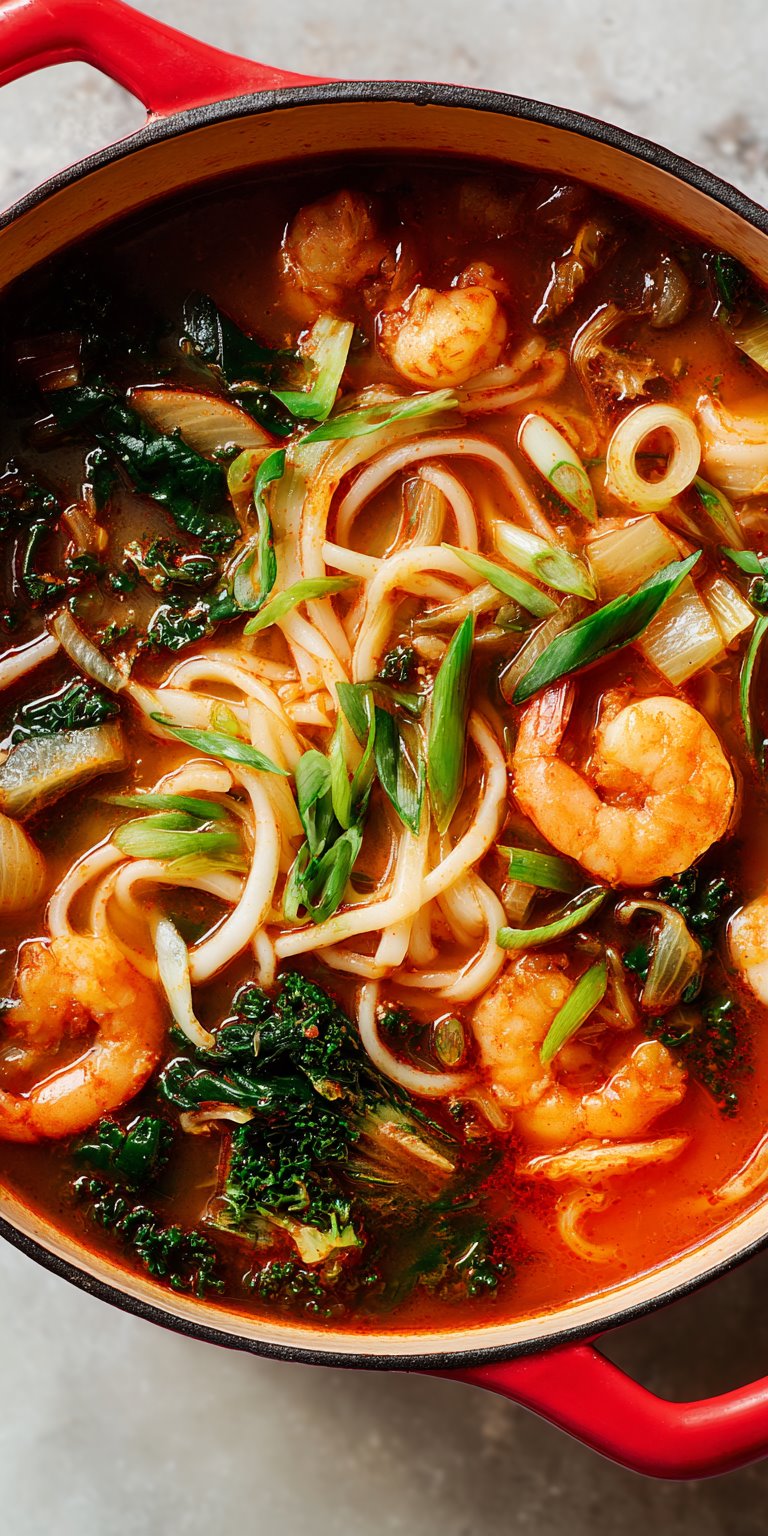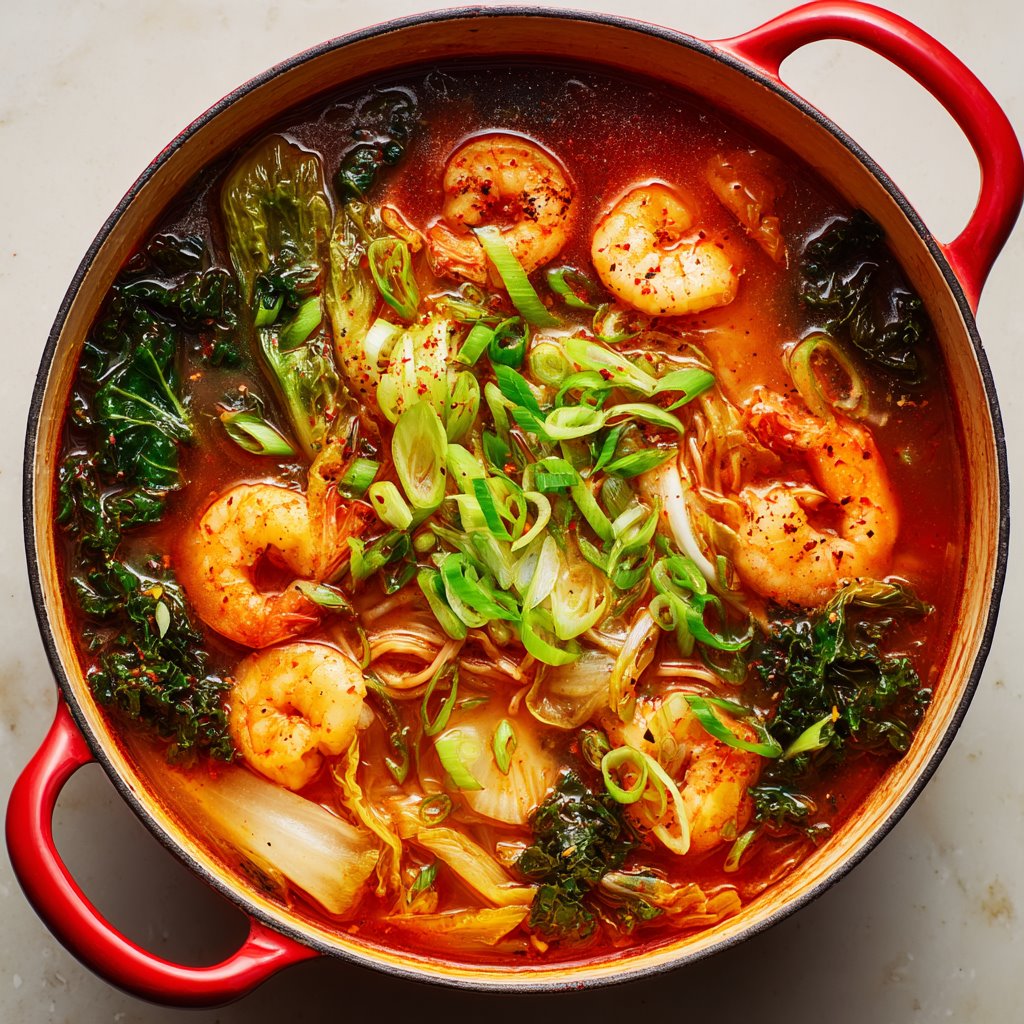There’s nothing quite like a steaming bowl of Jjamppong — the fiery, seafood-packed Korean noodle soup bursting with bold flavors.
Each spoonful delivers the perfect balance of spice, umami, and ocean freshness that warms you from the inside out.
Why You’ll Love This Recipe
This Jjamppong recipe brings authentic Korean restaurant flavor to your home kitchen.
The spicy broth is infused with gochujang and gochugaru for rich depth, while the seafood adds natural sweetness.
It’s hearty, comforting, and ready in less than 30 minutes.
What You’ll Need (Ingredient Highlights)
Korean fresh noodles provide the perfect chewy texture to soak up the flavorful broth.
A mix of shrimp, clams, squid, and scallops creates a rich, layered seafood flavor.
Gochujang (Korean chili paste) adds spicy, savory complexity, while gochugaru (Korean chili powder) brings heat.
Napa cabbage and bok choy add crunch and freshness.
Chicken or bone broth forms a deep, savory base that ties it all together.
Pro Tips Before You Start
Use fresh seafood for the cleanest flavor and texture.
Don’t overcook the noodles; they’ll finish cooking in the soup.
Adjust spice levels by reducing or increasing gochugaru.
Add a splash of soy sauce at the end for umami balance.

How to Make Jjamppong (Korean Seafood Noodle Soup)
Step 1 – Cook the noodles
Boil the Korean fresh noodles until al dente. Drain and set aside.
Step 2 – Sauté the aromatics
Heat oil in a large pot over high heat.
Add garlic and onion, and stir-fry until fragrant.
Step 3 – Add seafood and spices
Add shrimp, clams, squid, and scallops.
Stir in gochujang and gochugaru, coating everything evenly.
Step 4 – Build the broth
Pour in chicken or bone broth.
Add napa cabbage and bok choy. Bring to a boil.
Step 5 – Season and finish
Add soy sauce and salt to taste.
Return the noodles to the pot and cook for 30 seconds. Stir in scallions, then remove from heat.
What to Serve It With
Serve with kimchi for an authentic Korean touch.
Pair with pickled radish or steamed rice to balance the heat.
Variations / Substitutions
Use mussels instead of clams or add fish slices for extra seafood depth.
For a vegetarian version, replace seafood with mushrooms and use vegetable broth.
Add pork slices or tofu for a different protein twist.
Storage & Leftovers
Store leftover broth and noodles separately in airtight containers.
Refrigerate for up to 2 days and reheat gently on the stove before serving.
FAQs
Can I make Jjamppong less spicy?
Yes, reduce the amount of gochugaru or substitute mild chili paste.
What kind of noodles work best?
Korean wheat noodles or ramen-style noodles are ideal.
Can I use frozen seafood?
Yes, but thaw and drain well before cooking.
How can I make the broth richer?
Simmer longer or use bone broth for extra depth.
Can I prepare this dish ahead of time?
You can make the broth in advance and add noodles when serving.
What vegetables can I add?
Try mushrooms, carrots, or bell peppers for extra flavor.
Can I use chicken or pork instead of seafood?
Yes, thinly sliced meat works great in place of seafood.
How do I keep the noodles from getting soggy?
Store noodles separately and add them to the broth just before eating.
Is Jjamppong gluten-free?
Use gluten-free noodles and ensure your gochujang is gluten-free.
What can I serve with Jjamppong?
Kimchi, pickled vegetables, or steamed dumplings pair perfectly.
Final Thoughts
This Jjamppong delivers a bold kick of spice and briny seafood flavor in every bite.
It’s a comforting, satisfying noodle soup that brings the heart of Korean cuisine to your table.
